The Christmas wreath, a natural circle, represents the Mother on her day, the Winter Solstice. Another expression of the Triple Goddess occurs during the Civil War period and much of it is set at the warm glow of the hearth at the Christmas season. Louisa May Alcott’s Little Women is a virtual biography of the Three Women archetype. The novel is set at a time when millions of impoverished immigrants were pouring into
Natural Religion we used to call it in 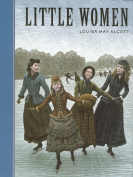 Yankee and its moral sensibility evolved out of the Transcendentalist Movement, as the author was the daughter of Bronson Alcott, who, with Emerson and Thoreau, was one of the three High Elves of the
Yankee and its moral sensibility evolved out of the Transcendentalist Movement, as the author was the daughter of Bronson Alcott, who, with Emerson and Thoreau, was one of the three High Elves of the
Musical girl groups usually come in threes; The Andrew Sisters, The Lennon Sisters, The Supremes, The Dixie Chicks, The Mandrell Sisters. But the archetype of the Three Women more or less disappeared from the culture during the rise of federalism after the Civil War. It was as if she was frozen out of time during
 Like James McNeill Whistler’s painting of his mother immobilized in the chair, Arrangement in Grey and Black, No. 1 (1871), her gaze resolutely fixed on the past. In the early Western tradition Mary is usually on the left, facing right, like classical portraiture, which carries the eye from the left front of the picture to the right rear and in the positive (linear) direction of future time, like the direction of the math arrow for positive numbers (and the “Darwin” fish on cars). In the Mona Lisa, painted when Leonardo returned to
Like James McNeill Whistler’s painting of his mother immobilized in the chair, Arrangement in Grey and Black, No. 1 (1871), her gaze resolutely fixed on the past. In the early Western tradition Mary is usually on the left, facing right, like classical portraiture, which carries the eye from the left front of the picture to the right rear and in the positive (linear) direction of future time, like the direction of the math arrow for positive numbers (and the “Darwin” fish on cars). In the Mona Lisa, painted when Leonardo returned to 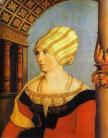 without her charge and looking left of frame in 1516. 350 years later, the woman is very old and facing dead left, the direction of the Inner Life as Whistler’s mother ( like the direction of the math arrow for minus and the “Jesus” fish). – suggesting past time and the looking into the Unconscious, now very far away and in a crate “nature” is in a tiny frame in the upper corner This change accompanies the rise of the Renaissance and the ascent of the Power Principle. All organic artists naturally understand this. Composition of paintings like described is the same as the composition of dreams and the composition of classic movies, such as Akira Kirosawa’s Dreams, Throne of Blood and The Seven Samurai, all of which yield to this kind of explication.
without her charge and looking left of frame in 1516. 350 years later, the woman is very old and facing dead left, the direction of the Inner Life as Whistler’s mother ( like the direction of the math arrow for minus and the “Jesus” fish). – suggesting past time and the looking into the Unconscious, now very far away and in a crate “nature” is in a tiny frame in the upper corner This change accompanies the rise of the Renaissance and the ascent of the Power Principle. All organic artists naturally understand this. Composition of paintings like described is the same as the composition of dreams and the composition of classic movies, such as Akira Kirosawa’s Dreams, Throne of Blood and The Seven Samurai, all of which yield to this kind of explication.
At the turn of the century and up into the 1950s, respected Western authors and literary figures consistently presented an image of women as desiccated or gone mad. A critical position accuses these artists of creating dark images of women by a misogynist power driven culture. I think there is truth to that. But the archetypal point of view has it that the artist lives in a different realm of creativity. As it is in Zen, the true artist doesn’t create anything. S/he merely sees what is there. This amounts to the same thing. Power despises love and builds its own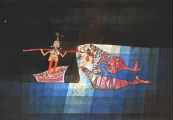 edifice. The artist is much like the Paul Klee’s image of the man in the front of the boat, spear in hand, following down a murky river, peering into the unknown. This picture speaks masterfully of any and all journeys into the unconsicous, whether artist, musician or dreamer. Klee shows no intention but seeks to presents what is there - and see tht the Unconscious (the water) is light in the artist's vision, the everyday dark..
edifice. The artist is much like the Paul Klee’s image of the man in the front of the boat, spear in hand, following down a murky river, peering into the unknown. This picture speaks masterfully of any and all journeys into the unconsicous, whether artist, musician or dreamer. Klee shows no intention but seeks to presents what is there - and see tht the Unconscious (the water) is light in the artist's vision, the everyday dark..
 What these artists saw growing into the 20th century was the paralyzing Death Mother, Kali the Destroyer, in her finest hour. Abstract Expressionist William de Kooning offers Kali in his “Woman” series of the post-war 1940s and early 1950s. The Death Mother, rising from the unconscious “deep” was ready for her close-up in 1956 in the Japanese classic Gojira, directed
What these artists saw growing into the 20th century was the paralyzing Death Mother, Kali the Destroyer, in her finest hour. Abstract Expressionist William de Kooning offers Kali in his “Woman” series of the post-war 1940s and early 1950s. The Death Mother, rising from the unconscious “deep” was ready for her close-up in 1956 in the Japanese classic Gojira, directed by Inoshiro Honda, distributed in the West as Godzilla, King of the Monsters (in the 1998 remake, the “king” had babies. Godzilla is the dark side of the Lady in the
by Inoshiro Honda, distributed in the West as Godzilla, King of the Monsters (in the 1998 remake, the “king” had babies. Godzilla is the dark side of the Lady in the
Early in the century, Thomas Mann saw the European yin and yang as the burgher and the insane female (the exact reversal of the Madonna and Child), and Allen Ginsburg presented the mad woman in his poem Howl in the 1950s. Norman Mailer addressed modern times in the 1950s with a column in The Village Voice, contrasted the avant garde man as a psychoanalyst, and the woman as a prostitute. And his novel An American Dream presented the protagonist’s love interest as a whore as well.
A vivid image of woman relieved of all healthy and positive psychic content is found in Earnest Hemingway’s short story, After the Storm. Hemingway, perfect master of loss and chronicler of the crippling inabilities of men who live without women, has his protagonist rowing a skiff after a storm to ward off a hangover. He finds an ocean liner has sunk unnoticed during the storm. Swimming underwater into the “unconscious” of the ocean and peering into the ship’s port hole, he sees his anima, or his female nature; his Psyche beneath the sea. It is a dead woman staring out at him, her hair floating lightly in the blue lagoon on the other side of the glass.
 These shattered and debased feminine images echo widely today in pop culture - Snoop Dog, Tupak Shapur and Dr. Dre. Marilyn Manson and Alice Cooper project a Kali anima. The slimy creature who uses Lt. Ripley’s ovaries to produce her own nest in the Alien series is the Great Mother of all Kali figures, finding her place in space. This is an Aquarian turning point. The beast is born of Ripley but Ripley kills the beast and saves the Earth. With Ripley, the Earth Mother begins her return to earth and generally speaking, the culture will return with her. But as she says, she is herself a stranger to Earth - her true nature. She is a “new” person, born in space and part alien.
These shattered and debased feminine images echo widely today in pop culture - Snoop Dog, Tupak Shapur and Dr. Dre. Marilyn Manson and Alice Cooper project a Kali anima. The slimy creature who uses Lt. Ripley’s ovaries to produce her own nest in the Alien series is the Great Mother of all Kali figures, finding her place in space. This is an Aquarian turning point. The beast is born of Ripley but Ripley kills the beast and saves the Earth. With Ripley, the Earth Mother begins her return to earth and generally speaking, the culture will return with her. But as she says, she is herself a stranger to Earth - her true nature. She is a “new” person, born in space and part alien.
In the Sixties the sleeping woman awakened. There is today a small industry making worthy and worthwhile claims for her resurrection, but the forty million of my age will recall Her first primal cry as if she was the same woman in Hemingway’s port hole who was not dead but had only been underwater holding her breath in the Havana lagoon for the past 50 years and now in the summer of 1967 she came roaring to the surface in the San Francisco ballrooms, the Avalon and the Fillmore, where she was given this breathless and coarse reintroduction to the world: “ . . . four gentlemen and one great, great broad . . .” It was Janis Joplin, egging on her men (“C’mon, boys!”), Big Brother and the Holding Company. (Like Princess Amidala, Janis, “queen of the hippies,” came with a double; Grace Slick of Jefferson Airplane fame.)
resurrection, but the forty million of my age will recall Her first primal cry as if she was the same woman in Hemingway’s port hole who was not dead but had only been underwater holding her breath in the Havana lagoon for the past 50 years and now in the summer of 1967 she came roaring to the surface in the San Francisco ballrooms, the Avalon and the Fillmore, where she was given this breathless and coarse reintroduction to the world: “ . . . four gentlemen and one great, great broad . . .” It was Janis Joplin, egging on her men (“C’mon, boys!”), Big Brother and the Holding Company. (Like Princess Amidala, Janis, “queen of the hippies,” came with a double; Grace Slick of Jefferson Airplane fame.)
And shortly thereafter, the Three Little Women left behind in  intervention and by a magical talisman; a single feather from a magical animal, a duck that stretched its neck to become a swan, brought from
intervention and by a magical talisman; a single feather from a magical animal, a duck that stretched its neck to become a swan, brought from
The circle of love and family broken in a hundred years of civil strife, global war and the threat of nuclear annihilation is restored by a single swan feather. And the three sisters live again in
It is interesting that in Willa Cather's masterpiece, My Ántonia, a "three sisters" American story like no other by an American writer like no other, the two "sisters" Tiny and Lena both find their way to San Fransisco as well, while Ántonia remains to farm on the Prairie. Written in 1918, the book is a vision of America as it wakens in the West, but the critical view of the rising Progressives (in the East) would send Cather into remission for almost a 100-year sleep. Possibly the best American novelist, she is barely taught in University, which is still under the shadow of attitutes of pre-war America and - out of sync with the rest of America - still looks to Europe and to Europeans for initiative and imagination. It is interesting that at the end of the novel Ántonia would abandon the English language for that which her family brougth from Prague.
Today The Three Women are everywhere. In archetypal characterizations, all celestial or other-worldly forms including aliens, primordial beings, Titans, superheroes, demi-gods and goddesses, are psychological entities -- archetypes -- in different forms. That includes angels, as in the three Charlie’s Angels.
 Xena, the warrior princess with her circular chakrum, was a run-away pop-star at the end of the millennium and one episode actually featured her in triplicate. The episode in which Xena was supposedly reformed from beating people up came when she was banished to
Xena, the warrior princess with her circular chakrum, was a run-away pop-star at the end of the millennium and one episode actually featured her in triplicate. The episode in which Xena was supposedly reformed from beating people up came when she was banished to
The final episode of Xena: Warrior Princess is an extravaganza Hong Kong-style karate opera with flying samurai, spirit women and monsters from the underworld. Xena is crucified (for at least the second time) and beheaded but in death she lives in the “Dark World” united with her spirit guide where she continues her battles.
There was also a new TV show in the late 1990s called Charmed, in which three young women in
And the goddess was in the air, as young Jakob Dylan’s Three Marlenas (“. . . see no, speak no, hear no evil about us,”) became a popular hit. Unique among these new groups was Ulali, formed in 1987, a First Nations women a cappella trio that sings in the many styles and languages of their ancestors in the western hemisphere (with language which resembles Tolkien’s Tom Bombadil, a characterization of the Green Man: “We are older than America can ever be and do not know the borders,” they sing. “Our brothers and sisters run from North to South and into and under the waters for miles and years back.”)
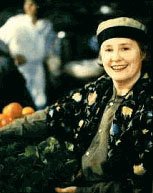 Today,
Today, 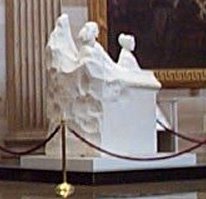 Capital in
Capital in
In astrological terms, earth and water are signs of the feminine, while air and fire are male signs. Invariably, the Mother was associated with the Earth when devotion was strong. You can see this in the oldest church paintings: Mary is an almost yogic figure, pictured in a cave or a stable and surrounded by low hills and quiet paths of water. This is one of the latest, in 15th century Italy by Sassetta, but still carries the Taoist, quiet, Earth Mother theme.
stable and surrounded by low hills and quiet paths of water. This is one of the latest, in 15th century Italy by Sassetta, but still carries the Taoist, quiet, Earth Mother theme.
This changes at the beginning of the Renaissance and instead, Jesus is presented as central, and he is often in the sky, the masculine field. Increasingly, as Renaissance culture progresses, the action of church frescos and painting leaves the Earth and takes place in the Sky. Mary is presented later in the Renaissance frescoes in the sky, but there she is a secondary figure. Leonardo’s Mona Lisa is among the very last pictures to present a Madonna-like portrait in a context of earth and flowing water, and that is the last of the Earth Mother in European art during the Christian period.
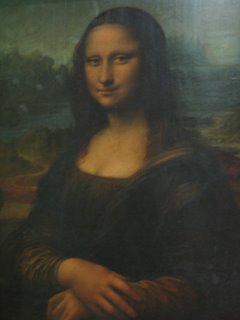 What is noteworthy about the famous Leonardo picture, in actuality the portrait of a local governor’s wife, is that the picture resembles the long tradition of the Madonna and child motif of Mary and the baby Jesus, but the boy child is missing from the picture. The Madonna/boy child traditionally expressed a Christian tai chi motif, bringing in the yin and yang elements into the early Christian world as they had played through history from the ancient days of the Earth Mother (White Goddess and her Star Child, born annually on the Winter Solstice) to the Renaissance.
What is noteworthy about the famous Leonardo picture, in actuality the portrait of a local governor’s wife, is that the picture resembles the long tradition of the Madonna and child motif of Mary and the baby Jesus, but the boy child is missing from the picture. The Madonna/boy child traditionally expressed a Christian tai chi motif, bringing in the yin and yang elements into the early Christian world as they had played through history from the ancient days of the Earth Mother (White Goddess and her Star Child, born annually on the Winter Solstice) to the Renaissance.
When the White Goddess governed the heart of the European, the yin dominated the energy and the yang was left in boyhood or infancy, submissive to the yin. This is virtually the psychological history of the European until the end of the Medieval period. In the Mona Lisa Leonardo presents the Madonna left alone without her charge as the Power Principle ascended into the Renaissance, the yin force of the Earth Mother removed from the ascending yang. An alchemist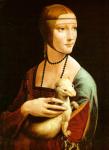 and a devotee of the Earth Mother who worked on commission from an aggressive imperial Pope beginning Europe’s march across the world, starting with the nearby Islamic regions, Leonardo adds a malevolent aspect in a similar portrait classically modeled on Virgin and Child, but with a weasel in the place of the child (Lady with an Ermine).
and a devotee of the Earth Mother who worked on commission from an aggressive imperial Pope beginning Europe’s march across the world, starting with the nearby Islamic regions, Leonardo adds a malevolent aspect in a similar portrait classically modeled on Virgin and Child, but with a weasel in the place of the child (Lady with an Ermine).
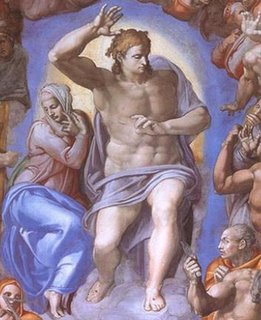 Michelangelo’s journals show that he fully embrased the warrior’s challenge presented to him by the imperial Pope. On the Sistene Chapel he would present Jesus in strong and naked masculinity, with Mary scorned and virtually cast aside with the Christ almost in disgust. He is alone now and without the yin force, rising into the sky, yang without yin, expressing the separation that would be characteristic of the next 500 years - the separation of son from mother and the separation of Christian from the Earth. From this moment on out, the European would be marked by detachment, disassociation, psychological division and schizophrenia.
Michelangelo’s journals show that he fully embrased the warrior’s challenge presented to him by the imperial Pope. On the Sistene Chapel he would present Jesus in strong and naked masculinity, with Mary scorned and virtually cast aside with the Christ almost in disgust. He is alone now and without the yin force, rising into the sky, yang without yin, expressing the separation that would be characteristic of the next 500 years - the separation of son from mother and the separation of Christian from the Earth. From this moment on out, the European would be marked by detachment, disassociation, psychological division and schizophrenia.
 Michelangelo's sculpture called The Bruges Madonna (1504) represents an extraordinary turning point in Western history. It shows the babe grown to boy releasing from his mother’s grasp and wrestling his way to the ground. In his journals, Michelangelo clearly states that the boy child is ready to accept his duty and take his place in the world. In the confluence of commissioned images that came from Michelangelo and Leonardo at this time there is no ambiguity of public purpose. This was the moment in history when
Michelangelo's sculpture called The Bruges Madonna (1504) represents an extraordinary turning point in Western history. It shows the babe grown to boy releasing from his mother’s grasp and wrestling his way to the ground. In his journals, Michelangelo clearly states that the boy child is ready to accept his duty and take his place in the world. In the confluence of commissioned images that came from Michelangelo and Leonardo at this time there is no ambiguity of public purpose. This was the moment in history when
In Catholic Churches throughout the world today, Mary is pictured high in the sky as a giant standing on the world, a globe about the size of a basketball. Beneath her feet is a snake, generally a black snake. It is pictured as a dead snake. This is the female energy of the Earth Mother left behind when the church and European civilization embraced the rational and the masculine outlook and moved toward the Power Principle.
generally a black snake. It is pictured as a dead snake. This is the female energy of the Earth Mother left behind when the church and European civilization embraced the rational and the masculine outlook and moved toward the Power Principle.
 But the snake is not dead. It cannot die, because if the snake dies, the world dies. Janis Joplin was first evidence that the snake beneath the feet of the Blessed Mother was still alive. It is worth noting and it is significant, that the Janis uprising took place in
But the snake is not dead. It cannot die, because if the snake dies, the world dies. Janis Joplin was first evidence that the snake beneath the feet of the Blessed Mother was still alive. It is worth noting and it is significant, that the Janis uprising took place in
The Earth Mother lives wherever there are low hills, quiet water and quiet hearts, but on the West Coast, she has brought a new awakening that will have historic consequences for the American continent and for the world. Perhaps as in the Xena series and in Amy Tan’s novels this spirit force will come from the East. Madame Blavatsky made this claim that it would over 100 years ago.
have historic consequences for the American continent and for the world. Perhaps as in the Xena series and in Amy Tan’s novels this spirit force will come from the East. Madame Blavatsky made this claim that it would over 100 years ago.

No comments:
Post a Comment